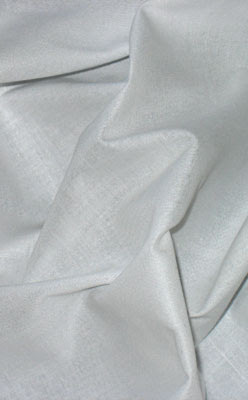In this video I’m sharing more updates to my studio, with the spotlight on new fabric and fibers. In another video we reviewed new products and equipment (see Studio Updates: New Gear). It’s always fun to try new ideas and new techniques. I may not use everything this year, but I like to be “tooled up” and ready.
Mercerized Cotton Fabric
One acquisition is two yards of bleached, 100% mercerized cotton print cloth (CPC) from Dharma Trading Company. The fabric is used by quilters, sewers, beginning dyers, and fabric painters. Mercerization is a process applied to plant fibers to increase luster. It is applied to fabric after weaving, or to yarns and threads after spinning. Mercerized fibers absorb more water, and therefore more dye, making the color of the dyed cloth brighter and deeper (sometimes by as much as 25%). The process gives cloth better color resistance over multiple washings, increased strength, smoothness, resistance to mildew, and reduced lint.
 |
| Mercerized Cotton Fabric (note the luster) Photo Credit: Dharma Trading Company |
Linen Fabric (Plant-based)
Another acquisition is one yard of bleached, 100% linen fabric, also from Dharma Trading. Linen is durable, breathes, and is good for dyeing. It maintains density during use, and does not lose color.
 |
| Linen Fabric (medium weight) Photo Credit: Dharma Trading Company |
Linen Party Napkins (Plant-based)
These small 100% linen napkins are carried by Amazon. They are described as being soft, with a heavyweight feel, 6" x 6", with elegant ladder hem-stitching and mitered corners. I’ve never dyed with linen, so am interested to see how well it absorbs color.
 |
| Linen Party Napkins Photo Credit: Amazon |
Silk Satin Scarves (Protein-based)
These silk satin scarves are also a departure since I’ve never dyed protein-based fiber. They are 8" x 54", though many other shapes and sizes are available from Dharma Trading Company. The hems are hand rolled with 100% silk thread, and the scarves are ready to dye and paint. I plan to use the silk for eco-dying – the direct transfer of color from plant to fiber, with the right mordant.
 |
| Silk Satin Scarves with Rolled Hems Photo Credit: Dharma Trading Company |
Peruvian Highland Wool Yarn (Protein-based)
This Peruvian Highland 100% wool yarn is also a departure into protein-based fiber. The sturdy, all-purpose yarn is distributed by Amazon. I’m not a knitter, but the description says the yarn is used for cable stitch patterns, intricate winter sweaters, textured stitches, and everyday accessories. It also felts beautifully. I purposefully purchased this lovely Mink Heather color, to try overdyeing. Overdyeing is the process of dyeing previously dyed fiber, with the intent to further change the color. I have 100 yards.
 |
| Peruvian Highland Wool Yarn Photo Credit: Amazon |
Cotton Dish Towels
These cotton dish towels are an old favorite and always in my arsenal of fabric. We’ve been dyeing them since the beginning, and they remain a standard.
 |
| Cotton Dish Towels Photo Credit: Target (Made by Design) |
Leftovers from Last Year
We also have some leftovers from last year, including large and small cotton handkerchiefs, and cotton dinner napkins. Some have never been dyed. Others have been dyed, and I plan to overdye them.
Recycle Dyeing
Finally, I’ve been combing thrift shops and my own wardrobe for items to dye. Old T-shirts perk up nicely in the dye bath, and fabric from various sources may wind up in a quilting project. Very sustainable!
 |
| Reuse and repurpose old fabric |
Well, that is it for now. As you can see, I have lots of plans, but may run out of time. Whatever I decide to do, I’m tooled up with various fabric and fiber types and ready to dye!
No comments:
Post a Comment